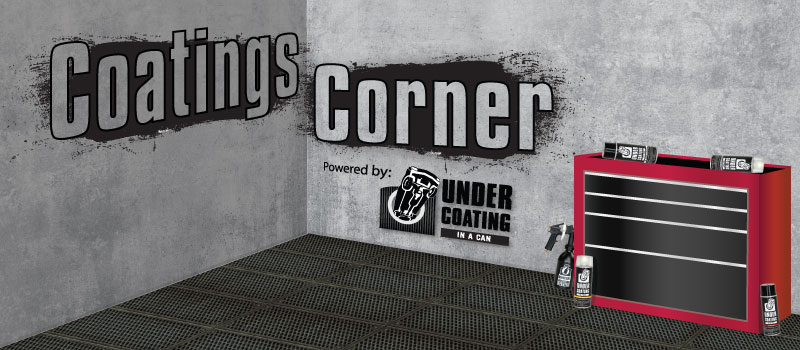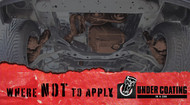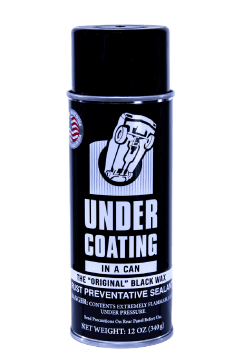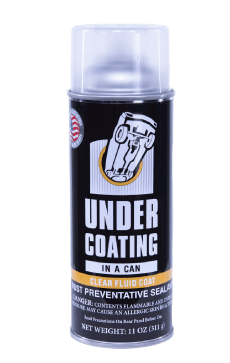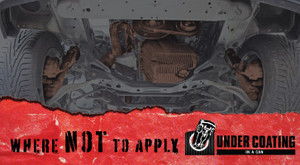Where NOT to Apply Your Undercoating
By on Jul 15th 2025
You’ve got the can all shaken up and ready to go with dreams of a rust-free ride in mind, but before you go full Picasso on your vehicle’s undercarriage, it’s worth knowing where you SHOULDN’T spray it.
Undercoating is a game changer for providing corrosion and rust protection to the bottom of your vehicle, but if you coat the wrong parts, you’re not just sealing out the rust; you’re sealing in future problems. Save yourself from disaster; before you apply undercoating to your vehicle, make sure to avoid spraying these areas:
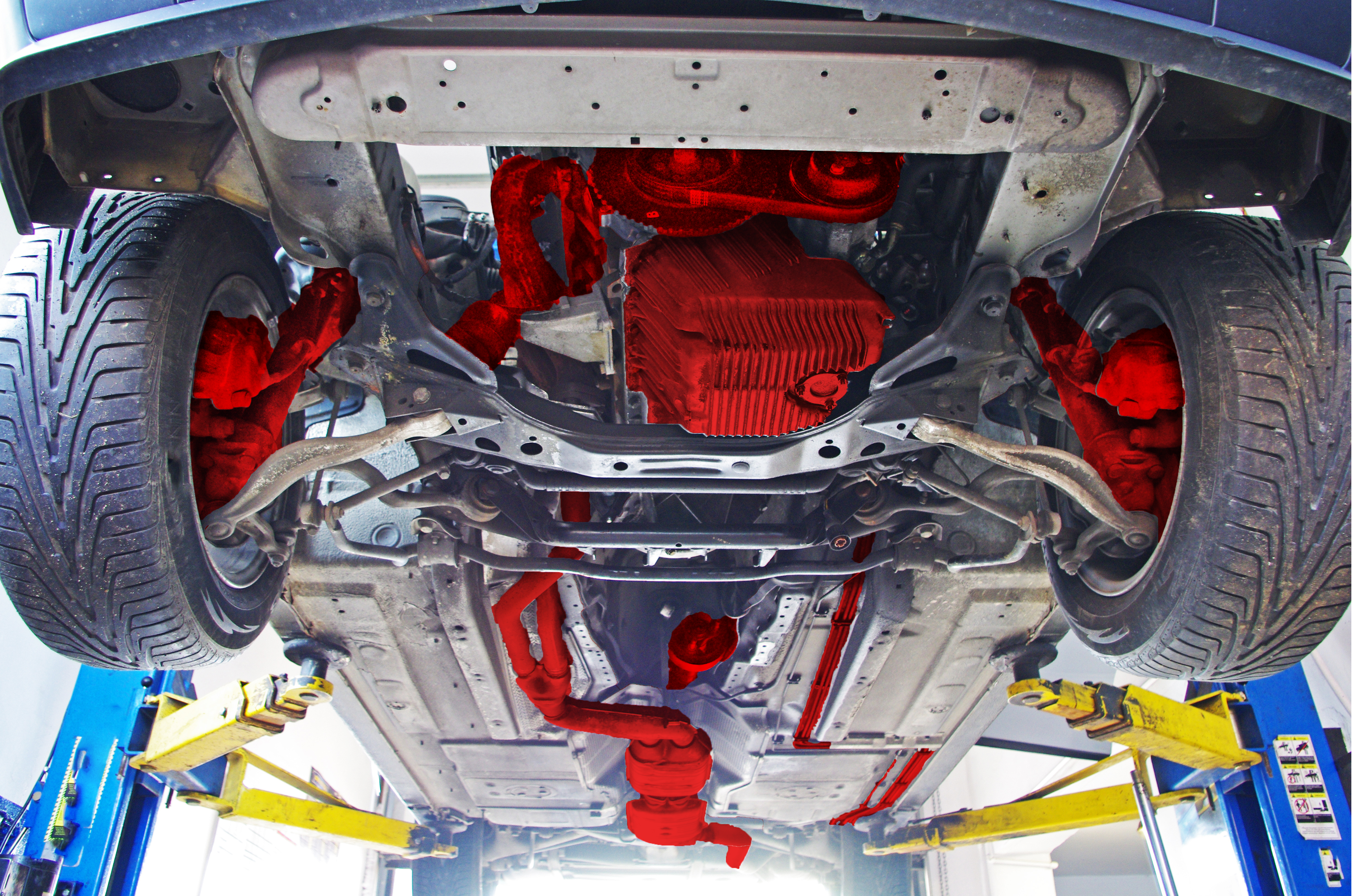
The areas you SHOULD NOT coat are highlighted in red above.
NOTE: Every vehicle is different; this diagram is a general guide to areas commonly avoided while undercoating.
Brake Caliper & Rotor
The calipers and rotors of the brakes should be shielded from the undercoating process because if sprayed, it could interfere with braking performance and heat dissipation—and that’s a danger you’ll want to steer clear of. It could even potentially contaminate the brake pads, causing them to perform less effectively. Believe us, this is definitely not a risk worth taking.
Engine Oil Pan and Transmission Case
These components tend to get hot quickly and therefore are not to be messed with. It’s crucial to avoid any area of the vehicle that heats up, because if coated, the application could result in a burning odor, become a fire hazard, or interfere with heat dissipation and oil leak detection.
Exhaust System
The components of the exhaust system like the muffler, catalytic converter, and exhaust pipes also tend to get extremely hot and should be avoided when going on a spray-spree with that undercoating to prevent fire hazards.
Oil Lines/Transmission Cooling Lines
These lines carry engine or transmission fluid. If they were to be coated, it could cause loads of maintenance hazards due to trapped heat or hidden leaks in the lines. Neither you nor your mechanic will be happy about this one.
Suspension components
If you opted for the rubberized or asphalt-based undercoating, be sure to cover any suspension components from the undercarriage of your vehicle. Being that these types of undercoating dry hard, once settled, they could affect the performance of these systems, so it’s best to avoid the hassle by covering them prior to spraying the undercoating.
Steering Components
This includes the driveshaft, tie rod ends, ball joints, and control arms. Don’t apply undercoating to these components because it will affect the steering capabilities of your vehicle. The steering linkage should remain undercoating-free because it must remain flexible to function properly while the automobile is in motion.
Drainage Areas
Avoid blocking weep holes or vents located under your car. Applying undercoating in these areas can trap moisture and end up causing rust instead of preventing it.
Rubber Seals
If undercoating is sprayed over rubber, it could cause issues such as swelling, restriction of movement, and chemical degradation. This can make those rubber seals leak…and no one wants that.
Cameras and Sensors
If you’re cruising around in a modern car or truck, the odds are that you have the luxury of a camera or sensor linked to the bottom of your ride. Try to avoid spraying these, because covering up that camera lens/sensor would affect its capabilities and accuracy. Once you’ve driven with a sensor, it can be difficult going back to just “eyeballing” it.
How to Spot a Mistake After Undercoating
Your vehicle won’t lie--that undercoating ended up in a spot where it wasn’t welcome, there would be obvious signs that everything is not A-okay.
After undercoating, monitor your vehicle performance for these symptoms that could indicate over spraying/coating in an area you probably shouldn’t have.
- Burning Odors or Smoke: If you notice smoke or a strong smell like something is burning when driving, you may have applied undercoating to hot components of your vehicle like the exhaust or engine. This can be a serious fire hazard, so in this case, remove the undercoating immediately for your safety.
- Degraded Brake Performance: When undercoating is sprayed on rotors or calipers, it can lead to reduced braking power, uneven wear, and emanate a burnt odor over time.
- Noisy Suspensions: If there is loud squeaking or clunking noise coming from the bottom of the vehicle while in motion, your suspensions may not be moving freely due to the restriction from the undercoating.
- Steering Restriction: Tight or inconsistent steering is a sign that undercoating was sprayed over the steering linkage. The applied undercoating restricts the steering components and affects the visibility of the area, masking any wear or damage.
- Sensor or Wiring Issues: Check engine lights, ABS warnings, or intermittent issues are signs that the undercoating may have contaminated electrical connectors or sensors. This is especially common around the wheel speed and oxygen sensors.
How to Fix Undercoating Mishaps
So, you got a little carried away and sprayed over one of those areas you meant to avoid. Don’t worry, there’s no need to panic! It may not be a walk in the park to remove, but it’s still possible.
You’re in luck if you can catch the fluke before the undercoating skins over. A professional-strength degreaser like Spray Nine can be used to help dissolve the undercoating off unwanted areas in a pinch. Mineral Spirits can also be used as an effective solution in this scenario.
If the layer is too thick or dry for regular cleaning agents to get the job done, try using a pressure washer or putty knives to wash/scrape off the undercoating in that area. Mistakes can be reversible as long as you’re equipped with the right tools and products for the job!

